|
|
|
Sort Order |
|
|
|
Items / Page
|
|
|
|
|
|
|
| Srl | Item |
| 1 |
ID:
163203


|
|
|
|
|
| Summary/Abstract |
The little-known assassination in 1904 of governor general Bobrikov, the Russian ruler of Finland, by the Finnish Senate clerk Eugen Schauman can be explained as an act of tyrannicide, anarchism, or terrorism. The article analyzes the question of which category this deed fits into and discusses the local and international background of one of the most significant acts of violence in Nordic history. It also postulates that around the time of Bobrikov’s murder in 1904 a fundamental shift occurred in the usage of the term “terrorism,” which began to replace “anarchism” as the standard signifier for violent crimes against civilization as well as against specific political grievances and institutions.
|
|
|
|
|
|
|
|
|
|
|
|
|
|
|
|
| 2 |
ID:
163210
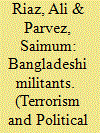

|
|
|
|
|
| Summary/Abstract |
Although militant groups have been present in Bangladesh since the 1990s, the country catapulted to international media attention on July 1, 2016, after an attack on a café in the upscale neighborhood of the capital Dhaka. The Islamic State claimed responsibility for the attack which killed 29 people, mostly foreigners. The attack came in the wake of a series of attacks on religious and ethnic minorities, foreigners, liberal activists, authors, and publishers by both an AQIS affiliate and ISIS. The government denied the existence of militant groups tied to international terrorist organizations. Despite these developments and instances of Bangladeshis joining the ISIS in Iraq and Syria, there has been very little in-depth discussion about who these militants are and what is driving Bangladeshis to militancy. This article addresses this lacuna. This paper examines the common traits of alleged Bangladeshi militants and explores the factors of radicalization. Drawing on media reports of the profiles of the alleged militants, between July 2014 and June 2015, and between July 2016 and August 2017, the article finds that most of the Bangladeshi militants are young, educated males increasingly coming from well-off families. We have also found evidence that four factors—social relationships, use of the Internet, personal crises, and external relations—appear most frequently in the narratives of Bangladeshi
|
|
|
|
|
|
|
|
|
|
|
|
|
|
|
|
| 3 |
ID:
163195
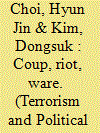

|
|
|
|
|
| Summary/Abstract |
This article explores how different types of governance systems shape different forms of political violence. We identify four governance types by combining the “institutional” dimension of coalition size represented by a minimum winning coalition (MWC) and the “ethno-political” dimension represented by the size of ethnic groups participating in the governing coalition. This study hypothesizes that (a) an exclusive system (small MWC; narrow-based ethnic coalition) is likely to engender civil war, (b) an oversized system (small MWC; broad-based ethnic coalition) is likely to generate a coup, and (c) an undersized system (large MWC; narrow-based ethnic coalition) is likely to stimulate riots or protests. Statistical analyses confirm all three hypotheses, implying that opposition groups choose alternative forms of conflict that maximize their chances of accessing power under different governance configurations. The article concludes by identifying three possible paths toward inclusive governance and suggesting that institutional reform before ethnic inclusion makes a transition toward inclusive governance far less dangerous.
|
|
|
|
|
|
|
|
|
|
|
|
|
|
|
|
| 4 |
ID:
163191
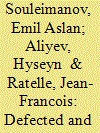

|
|
|
|
|
| Summary/Abstract |
Can former insurgents in the service of counterinsurgent paramilitaries be considered a perfectly loyal force? What mechanisms may help to deter subsequent defections of individuals who have already “betrayed” once? Drawing on a unique set of primary data, this article examines the effective counter-defection practices of Chechnya’s pro-Moscow paramilitaries toward prospective defectors from among ex-insurgents. It explores three interwoven mechanisms employed with various intensities to avert “double defections” at the peak of the locally fought counterinsurgency in Chechnya from 2000 to 2005. These mechanisms are: a) extrajudicial executions of recidivists and their relatives, b) initiation violence targeting insurgents’ relatives, and c) disclosure of the identities of defected insurgents who were responsible for killing insurgents in combat to the families of slain insurgents.
|
|
|
|
|
|
|
|
|
|
|
|
|
|
|
|
| 5 |
ID:
163190
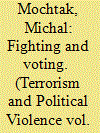

|
|
|
|
|
| Summary/Abstract |
lectoral disputes accompanied by violent outbreaks have become an emerging problem in societies under transformation, in authoritarian regimes, as well as in young democracies. The truth is that many politicians elected to office, their supporters, and political activists have altered their perceptions of electoral competition in a form of zero-sum logic with direct consequences for their opponents. After the fall of Communism in the beginning of the 1990s, Central and Eastern Europe stood at a crossroads. This period of imbalance and uncertainty affected the violent interaction in newly reformed electoral arenas with serious consequences for legitimizing democratic change. Despite the well-documented tension that existed in the region, the importance of violence in the electoral arena is rather neglected. The article approaches this gap as the first attempt to map electoral violence in a new typological environment where the process of transformation has affected political pluralism and the patterns of political contest. It argues that electoral violence is not a rare phenomenon in the region of post-Communist Europe and the dynamic varies on a great scale. Moreover, the article presents a picture of electoral violence occurring in different settings with potentially different contextual preconditions that need to be studied separately.
|
|
|
|
|
|
|
|
|
|
|
|
|
|
|
|
| 6 |
ID:
163202
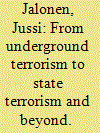

|
|
|
|
|
| Summary/Abstract |
Political terrorism has played an integral part in the independence struggle of several sovereign nations, and resistance and liberation movements have often had to resort to terrorism as a deliberate strategy. In the Finnish nationalist struggle for independence, a key role was played by the Jäger Movement, which combined the features of transnational war volunteerism and an underground organization. The military cooperation with Germany against the Russian Empire during the First World War, and the creation of the Finnish 27th Royal Prussian Jäger Battalion, also necessitated the establishment of a clandestine recruitment network in Finland, which effectively operated as an underground organization. During the war, the Jäger Movement was repeatedly faced with the question of resorting to reprisals and terror tactics. This process culminated in the autumn of 1916, and briefly showed signs of escalating to the level of an actual terror campaign, until it was cut short by the Russian February Revolution. Nonetheless, the accumulated propensity for political violence manifested itself during the subsequent Finnish Civil War, as well as during the far-right reaction of the early 1930s. The article approaches the question of terrorism in the Jäger Movement during this era, the issue of deploying “enforcement terror” during the independence struggle, and the subsequent distinctive participation of Jägers in state terror during the Civil War and the extreme right-wing political terror in the 1930s.
|
|
|
|
|
|
|
|
|
|
|
|
|
|
|
|
| 7 |
ID:
163207


|
|
|
|
|
| Summary/Abstract |
Why do women become extremists? To what extent might they have self-agency? This paper examines the motivations and processes of female radicalization into the so-called Islamic State (IS) by drawing on a case study of Indonesian IS sympathizers, including the three migrant workers-turned-female suicide bombers whose radicalization was facilitated by social media. It argues that far from being coerced, most women join IS of their own free will. Prompted by a mix of personal crisis and socioeconomic and political grievances, the women embark on a religious seeking, exploring the various Islamic options available to them. Ideational congruence might spark the initial interest in IS, but it is generally emotional factors such as a feeling of acceptance and empowerment that make them stay. Contrary to common assumptions, women’s subordination in jihadist organizations is not absolute; it can be negotiated after joining. Most women try to conform to jihadist strict gender rules, but some, often with the support of male allies, try to bend the norms, including on female combat roles. The findings suggest that counter-terrorism agencies should abandon the binary view that women are either just brainwashing victims or terrorist provocateurs, and try to understand the gendered nuances of radicalization in order to formulate suitable preventive measures.
|
|
|
|
|
|
|
|
|
|
|
|
|
|
|
|
| 8 |
ID:
163192
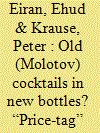

|
|
|
|
|
| Summary/Abstract |
In the early morning of July 31, 2015, masked attackers threw firebombs into two Palestinian homes in the West Bank village of Duma, south of Nablus, killing three Palestinian civilians. Contrary to claims by Israeli and Palestinian politicians, this attack was neither an isolated anomaly nor just another incident of settler violence. Instead, it was the latest attack in an important but largely unknown phenomenon called “price-tag,” in which a loosely connected group of young Israelis called “hilltop youth” burn Palestinian mosques and destroy property in hundreds of attacks accompanied by threatening graffiti that references Israeli settlers, outposts, and anti-Arab slogans. Using an original dataset of price-tag incidents and interviews with key actors, we demonstrate that the perpetrators, targets, and strategies of price-tag are different than previous patterns of settler violence. Whereas previous settlers saw the Israeli state as legitimate and largely decided to cooperate with it, the hilltop youth have decided to confront it by using price-tag attacks to deter settlement withdrawals and chain-gang the state into a conflict with the Palestinians. This analysis of the strategic logic of price-tag reveals its potential to shift the political landscape within and between Israelis and Palestinians.
|
|
|
|
|
|
|
|
|
|
|
|
|
|
|
|
| 9 |
ID:
163206


|
|
|
|
|
| Summary/Abstract |
How do individuals join Islamist extremist groups? Why do individuals support such groups? What factors contribute to a decision to join? What are the pathways into Islamist extremist groups? Drawing on examples from Pakistan, Bangladesh, Indonesia and the Philippines, the articles in this special issue address these critically important questions drawing on original fieldwork, new datasets and large scale national survey research. These articles explore the experiences and perceptions of men and women, South and Southeast Asians, living in majority Muslim and non-Muslim nations. Collectively, they illustrate the importance of social bonds&kinship ties, friendship, teacher-student ties and online relationships in creating a powerful sense of community that fosters a sense of belonging and eventual commitment. The goal of this special issue is to highlight the contributions that Asian cases can make to the often Middle Eastern and European-centric discourses on radicalization, joining and support for militancy.
|
|
|
|
|
|
|
|
|
|
|
|
|
|
|
|
| 10 |
ID:
163209
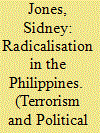

|
|
|
|
|
| Summary/Abstract |
The backgrounds of seven suspects arrested in connection with a September 2016 bombing in Davao, Philippines provide clues to how extremist ideology and support for ISIS took root in a middle-class urban environment. The seven men, part of the coalition that eventually took over Marawi in 2017, were drawn in by the idea of a caliphate, propaganda videos that became discussion material for charismatic young religious scholars, and the pull of friends and family. They represented overlapping networks of neighbours, business partners, and students. Their interwoven journeys to violent extremism provide a glimpse into how ISIS managed to transcend traditional clan and regional loyalties in the Philippines, but much more research is needed among pro-ISIS detainees to understand the phenomenon and take measures to address it.
|
|
|
|
|
|
|
|
|
|
|
|
|
|
|
|
| 11 |
ID:
163194
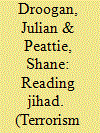

|
|
|
|
|
| Summary/Abstract |
Al Qaeda in the Arabian Peninsula’s Inspire magazine has received attention within Western academia and media for its role in inspiring and instructing a series of homegrown terrorist attacks. Reporting on the magazine often characterises it as a Western-centric instrument of jihadi discourse. This characterisation, while broadly accurate, is in need of refinement. Using a modified version of Jennifer Attride-Stirling’s method of thematic network analysis, this research visualises and analyses the narrative themes contained within fourteen issues of Inspire magazine. It demonstrates that the magazine’s narrative extends well beyond the Western world. In reality, Inspire’s themes centre not only on the West and its Muslim populations, but on local politics and broader religious issues. The magazine’s thematic focus has also shifted over time—particularly in response to (a) political volatility in the Middle East and North Africa, (b) the killing of prominent jihadists, and (c) the execution of successful individual jihad operations. Throughout these periods of change, Inspire struggled to maintain focus on its anti-Western narrative and proved easily distracted by local issues and the “martyrdom” of Al Qaeda leaders. Understanding Inspire’s thematic landscape and its shifting character prove important in understanding and responding effectively to its jihadi discourse.
|
|
|
|
|
|
|
|
|
|
|
|
|
|
|
|
| 12 |
ID:
163189
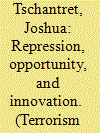

|
|
|
|
|
| Summary/Abstract |
How does state repression affect the incidence and impact of terrorism? This study conducts a process tracing analysis of the ongoing contention between the Uyghur separatist movement and the Chinese state to provide a plausible explanation for the present lack of consensus on this question. Relying on insights from collective action theory, it argues that although repression was initially successful in curtailing the opportunistic use of terrorism, novel political opportunity allowed some separatists to adopt innovations, such as suicide bombing, to circumvent repression. Repression has since proved ineffective in quelling terrorism, and will likely remain incapable of forestalling future terrorist innovations.
|
|
|
|
|
|
|
|
|
|
|
|
|
|
|
|
| 13 |
ID:
163199
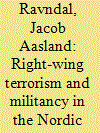

|
|
|
|
|
| Summary/Abstract |
Combining new quantitative and qualitative data, this article first describes and compares the evolution of right-wing terrorism and militancy in the Nordic countries between 1990 and 2015. Having established that Sweden has experienced considerably more right-wing terrorism and militancy than the other Nordic countries have, the article then seeks to account for Sweden’s outlier position. In doing so, the article draws on three concepts proposed by social movement research: organizational resources, political opportunities, and frame analysis. Applying these concepts to the Nordic countries, the study finds that Sweden’s outlier position may result from different WWII experiences, leaving Sweden with a stronger and more resilient extreme right movement, but also from receiving more immigrants while lacking influential anti-immigration (radical right) parties, and from conducting a more restrictive public debate on immigration, leaving little room for anti-immigration concerns in the public sphere. While the first two explanations are consistent with existing research, the third challenges the dominant view on how the public debate on immigration might influence extreme right mobilization and violence.
|
|
|
|
|
|
|
|
|
|
|
|
|
|
|
|
| 14 |
ID:
163193
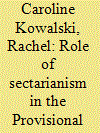

|
|
|
|
|
| Summary/Abstract |
This article concerns the nature of political violence in an ethnonationally divided society. The article engages with the debates surrounding the discrimination employed, or not, by the PIRA when selecting their targets and waging their campaign against British rule and partition in Ireland between 1969 and 1997. The piece challenges the assertion that the PIRA discriminated with religious bias, and that they actively targeted Protestant civilians. It does so by drawing upon analysis of original data collected for the piece, corroborated with qualitative primary sources including the memoirs of former PIRA members, and the sentiments of a former PIRA member turned informer, Sean O’Callaghan, who agreed to be interviewed for the piece. It is argued that the PIRA aimed only to kill individuals whom they deemed to be in some measure actively responsible for the persistence of British control in Ireland, and the prevention of a reunion with the Republic; and did so in a fashion that was, for the most part, blind to religious diversity. It is also argued, however, that the PIRA were either unable or unwilling to recognise the gap between the actual impact of their “armed struggle” and the intentions that lay behind it.
|
|
|
|
|
|
|
|
|
|
|
|
|
|
|
|
| 15 |
ID:
163197
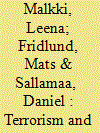

|
|
|
|
|
| Summary/Abstract |
The introductory article to the special issue discusses terrorism and political violence in the Nordic countries and reviews the state of academic research on the topic. Even though the Nordic countries appear to have suffered from lower levels of terrorism and political violence than many other Western states, they have been less void and peripheral with regard to such phenomena than common wisdom and academic scholarship would suggest. While some notable acts of violence like the July 2011 attacks in Norway have been covered in research literature to a certain degree, other phenomena such as far-right violence in Sweden have attracted less attention. The article discusses the ways in which the analysis of Nordic countries could contribute to the field of research and how articles included in the special issue address existing gaps in literature.
|
|
|
|
|
|
|
|
|
|
|
|
|
|
|
|
| 16 |
ID:
163204
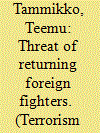

|
|
|
|
|
| Summary/Abstract |
The conflict in Syria and Iraq from 2011 onwards, and the Spanish Civil War in 1936–39 both witnessed a very relevant foreign fighter phenomenon. Even if the ideological drivers were different, both phenomena had a huge impact internationally on how foreign fighters were perceived as a threat in their home countries. In this article the official state responses to the two waves of foreign fighters have been compared with respect to the Finnish context. The volunteers in the Spanish conflict were regarded a security threat upon their return, since it was estimated that they might provide added expertise to the revolutionary left-wing movements in Finland. The returning volunteers from Syria-Iraq have not been perceived as a revolutionary threat to the Finnish political system, but as potential terrorists attacking the civilian population. After comparing different political contexts, it can be argued that the domestic political situation has in both cases had an impact on how the threats were answered in practice. Since the foreign fighters in Spain had significant political support among the growing left-wing parties, the Finnish state response towards them remained vague. In the Syria-Iraq case there has been no political support for the foreign fighters, and the issue has been effectively securitized.
|
|
|
|
|
|
|
|
|
|
|
|
|
|
|
|
| 17 |
ID:
163205
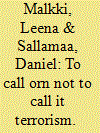

|
|
|
|
|
| Summary/Abstract |
This article looks at how domestic acts of ideologically-motivated violence have been treated in Finnish public discussion with a particular focus on how the word “terrorism” has and has not been used to characterize such incidents. The work demonstrates that Finnish public debate has, with certain notable exceptions, primarily avoided labelling any violent attacks in the country as terrorism. This reluctance stems from Finnish traditions of crisis management, counterterrorism, and politics. Furthermore, the propensity to use the term “terrorism” cannot be explained by such characteristics of the attack itself as the number of casualties or whether it was perpetrated by ingroup or outgroup members. Rather than “what has happened,” the question of calling or not calling an act terrorism comes down to the question of “what needs to be done.” The article contributes to academic debate by investigating a surprisingly under-researched aspect of how the term terrorism is used in public discussion while also shedding new light on the debate in Finland, a country seldom touched upon by research of terrorism and political violence.
|
|
|
|
|
|
|
|
|
|
|
|
|
|
|
|
| 18 |
ID:
163201
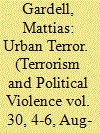

|
|
|
|
|
| Summary/Abstract |
White racist serial killer Peter Mangs is the most politically conscious lone wolf terrorist Sweden has seen thus far. Adopting the tactics of Joseph Paul Franklin to the city of Malmö, Mangs committed at least three murders and twelve murder attempts between 2003 and 2010. Well-versed in white power literature and leaderless resistance tactics, Mangs aimed at “igniting a race war” by shooting Black, Muslim, and Roma citizens to amplify racialized tensions, grievances, and anxieties in the increasingly segregated city. Yet, Mangs is not included in any database of single-actor terrorism, as these depend on how a perpetrator or incident is defined by the police, the courts, and the media. In this case, Mangs’ political motives were ignored by everyone, except by people in the targeted communities and the white racist milieu. This fact highlights the importance of ethnographic methods to terrorism studies. Based on ten three-hour interviews with Mangs, an analysis of his own political writings, previously not known to the public, interviews with Mangs’ victims, their friends and relatives, and extensive fieldwork in Malmö among activists across the political spectrum, including people who hailed Mangs’ deeds as heroic, this essay explores the impact of urban lone wolf terrorism.
|
|
|
|
|
|
|
|
|
|
|
|
|
|
|
|
| 19 |
ID:
163196


|
|
|
|
|
| Summary/Abstract |
This study discusses different media strategies followed by the Islamic State in Iraq and Syria (ISIS). In particular, the study attempts to understand the way ISIS’s video game that is called “Salil al-Sawarem” (The Clanging of the Swords) has been received by the online Arab public. The article argues that the goal behind making and releasing the video game was to gain publicity and attract attention to the group, and the general target was young people. The main technique used by ISIS is what I call “troll, flame, and engage.” The results indicate that the majority of comments are against ISIS and its game, though most of the top ten videos are favorable towards the group. The sectarian dimension between Sunnis and Shiites is highly emphasized in the online exchanges, and YouTube remains an active social networking site that is used by ISIS followers and sympathizers to promote the group and recruit others.
|
|
|
|
|
|
|
|
|
|
|
|
|
|
|
|
| 20 |
ID:
163208
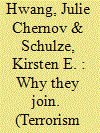

|
|
|
|
|
| Summary/Abstract |
Why do Indonesian Muslims join Islamist extremist groups? This article explores four pathways to entry into Indonesian militant groups: study sessions, local conflict, kinship, and schools. It argues that within all four of these pathways, social bonds and relationships are the common thread in encouraging entry as well as in fostering commitment. Specifically, these relationships contribute to the formation and eventual consolidation of one’s identity as a member of the jihadi group through regular participation in activities, attending meetings, narrowing the circle of friends to those within the group, and participating in increasingly risky and possibly violent activities together. Drawing on original fieldwork including 49 interviews with current and former members of Jemaah Islamiyah, Mujahidin KOMPAK, Darul Islam, Mujahidin Tanah Runtuh, Indonesia’s pro-ISIS network, and other jihadist groups as well as 57 depositions and court documents, this article explores the development and evolution of these pathways and how relational ties play a role in each
|
|
|
|
|
|
|
|
|
|
|
|
|
|
|
|
|
|
|
|
|